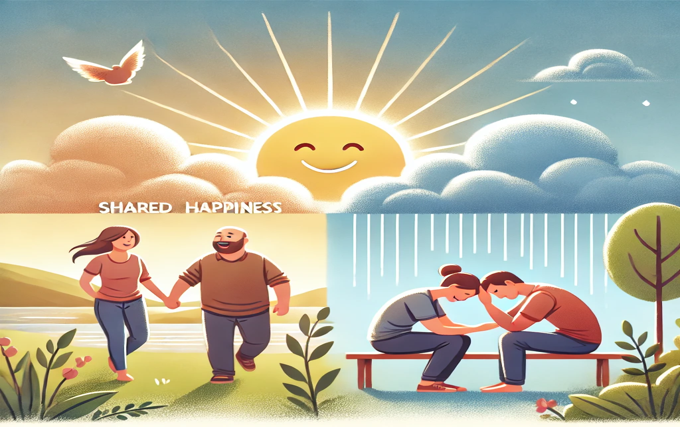In an increasingly individualistic world, the timeless wisdom encapsulated in the phrase “Shared joy is a double joy; shared sorrow is tymoff” resonates with profound simplicity. At its core, this adage emphasizes the transformative power of human connection and empathy. But to fully grasp its depth, we must explore its origins, its psychological and societal implications, and its relevance in modern life
The Origins of “Shared Joy is a Double Joy; Shared Sorrow is Tymoff”
The proverb “Shared joy is a double joy; shared sorrow is half a sorrow” has been a staple of human wisdom across cultures. While the precise origin of the “tymoff” addition remains unclear, it likely serves as an allusion to modern interpretations, philosophical musings, or even personal insights.
The underlying sentiment, however, has roots in collective human experiences. Ancient societies, with their strong communal bonds, lived by principles where shared experiences—both joyous and sorrowful—were central to the social fabric. Philosophers like Søren Kierkegaard and contemporary thinkers have echoed similar ideas, stressing the importance of shared emotions for individual and collective well-being.
Why Shared Joy Multiplies
The Psychology Behind Shared Joy
Joy, when shared, amplifies. This phenomenon isn’t merely anecdotal; it’s backed by science. Studies in positive psychology demonstrate that expressing happiness or sharing good news triggers the release of dopamine and oxytocin, the so-called “feel-good” chemicals in the brain. When you recount a joyful moment, you relive the positive emotions associated with it, and the person you share it with also benefits from the exchange.
For instance:
- Celebrations strengthen bonds: Think of birthdays, weddings, or festivals. These occasions are joyous because they involve others. Sharing these moments creates lasting memories and fosters relationships.
- Validation amplifies joy: When others acknowledge your happiness, it validates your emotions, making the experience more fulfilling.
The Role of Social Connection
Human beings are inherently social creatures. Evolutionary biologists suggest that our ancestors depended on group cohesion for survival, and the sharing of positive experiences played a crucial role in forming alliances and trust. In modern times, this manifests in activities like communal dining, storytelling, or online social interactions, where shared joy fosters a sense of belonging.
Shared Sorrow is Tymoff: Easing the Burden
Understanding Emotional Catharsis
On the flip side, sharing sorrow has the remarkable ability to alleviate emotional pain. “Tymoff” here might symbolize the gradual easing of emotional turmoil through sharing. Psychologists often advocate for venting or talking about one’s feelings, as doing so helps:
- Reduce emotional intensity: Articulating your sorrow allows you to process it, making it less overwhelming.
- Seek support: Sharing sorrow invites empathy and support, which can be deeply comforting.
- Foster perspective: Hearing others’ insights or similar experiences can provide clarity and reduce feelings of isolation.
The Science of Sharing Grief
Research in neuroscience supports the notion that shared sorrow diminishes personal pain. When someone listens to your troubles, the brain releases oxytocin, which fosters trust and reduces stress. Additionally, sharing sorrow activates the brain’s social bonding mechanisms, making the burden feel lighter.
The Modern Relevance of Shared Joy and Sorrow
In the Age of Social Media
Social media platforms have redefined how we share joy and sorrow. A milestone post, a heartfelt tweet, or even a supportive comment section can bring people together. However, this digital sharing has its pros and cons:
- Pros:
- Amplified reach ensures that your joy or grief receives widespread support.
- Virtual communities provide solace for those who feel isolated in real life.
- Cons:
- Superficial engagement might not offer the same comfort as genuine interactions.
- Oversharing or comparison may dilute the authenticity of emotions.
Workplace Dynamics
In professional environments, shared experiences often dictate team morale and productivity. Celebrating collective achievements boosts team spirit, while addressing setbacks together builds resilience. For instance, companies that foster open communication about challenges often report higher employee satisfaction and retention rates.
The Role of Cultural Practices
Across cultures, shared joy and sorrow manifest in unique ways:
- Festivals and communal gatherings: These celebrations are designed to multiply joy by involving entire communities.
- Rituals for grief: Funerals or remembrance ceremonies bring people together to share and process sorrow collectively.
Practical Ways to Share Joy and Sorrow
How to Share Joy
- Express gratitude: Acknowledge the people who contribute to your happiness.
- Celebrate together: Organize events or casual gatherings to share joyful moments.
- Use technology wisely: Share milestones via video calls or group chats to include distant loved ones.
How to Share Sorrow
- Open up to trusted individuals: Choose people who listen without judgment.
- Seek community support: Join groups or forums where you can connect with others facing similar challenges.
- Practice active listening: When others share their sorrow, be present and empathetic.
Why It Matters in the Long Run
The act of sharing joy and sorrow nurtures resilience and fosters emotional intelligence. For children, learning to share emotions lays the foundation for healthy relationships and coping mechanisms. For adults, it serves as a reminder that no one is truly alone in their journey.
Building Stronger Communities
When communities embrace shared experiences, they thrive. Mutual celebrations and collective mourning create a sense of solidarity, reducing social isolation and fostering a spirit of togetherness. This principle is evident in societies that prioritize communal living, where emotional sharing is integral to daily life.
Conclusion
“Shared joy is a double joy; shared sorrow is tymoff” encapsulates a profound truth about human nature. It highlights the undeniable importance of connection, empathy, and mutual support. Whether in the embrace of a loved one during tough times or the laughter shared with friends on a happy occasion, the act of sharing enriches our lives in immeasurable ways.
In a world that often prioritizes individual achievement, this adage reminds us to nurture our relationships and cherish the moments we share with others. After all, life’s most meaningful experiences are those we experience together.


